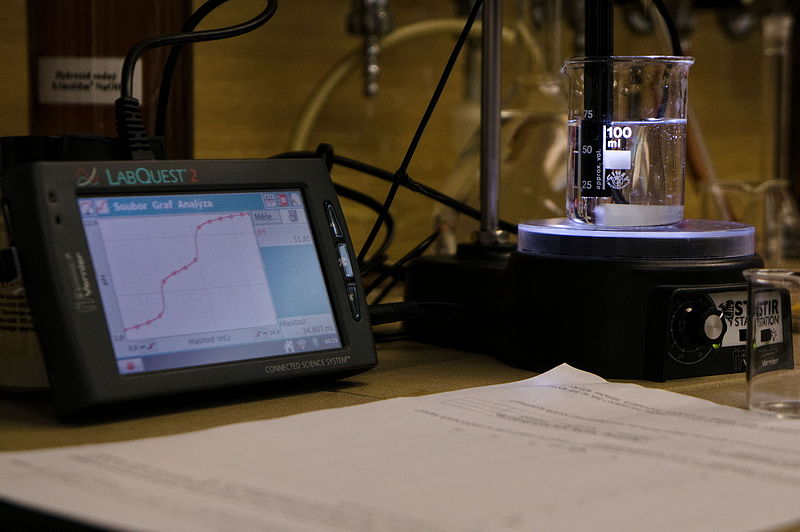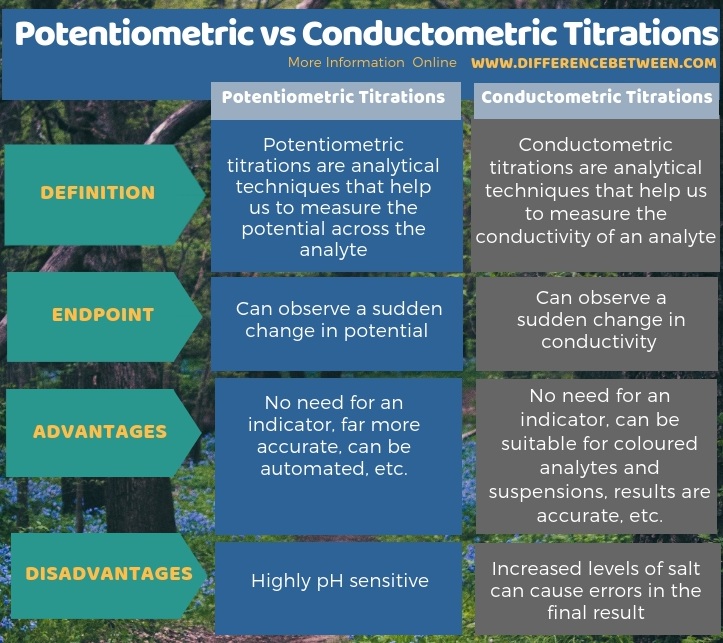The key difference between potentiometric and conductometric titrations is that potentiometric titrations measure the potential across the analyte, whereas conductometric titrations measure the electrolytic conductivity of the analyte.
A titration is an analytical technique in which we can determine the concentration of an analyte. Here, we need a titrant which acts as the standard solution having a known concentration. From this titrant, we can determine the concentration of an unknown solution. Besides, there are different types of titrations; redox titrations, potentiometric titrations, conductometric titrations, etc.
CONTENTS
1. Overview and Key Difference
2. What are Potentiometric Titrations
3. What are Conductometric Titrations
4. Side by Side Comparison –Potentiometric vs Conductometric Titrations in Tabular Form
5. Summary
What are Potentiometric Titrations?
Potentiometric titrations are analytical techniques that help us to measure the potential across the analyte. In this titration, we do not have to use an indicator to determine the endpoint of the titration. However, this titration is closely similar to a redox titration.
In the apparatus, we need two electrodes: an indicator electrode and a reference electrode. Generally, we use glass electrodes as indicator electrode and hydrogen electrodes, calomel electrodes and silver chloride electrodes as reference electrodes. The indicator electrode is important to monitor the end point of the titration. At the endpoint, the greatest change of potential can be observed.

Figure 01: There is a Sudden Change in Potential during Titration
When considering the advantages of this technique, it does not require an indicator and is far more accurate than a manual titration. Moreover, there are several types of potentiometric titration techniques that provide us with a great variety of options depending on the need. Also, this type of titrations works well with automated systems.
What are Conductometric Titrations?
Conductometric titrations are analytical techniques that help to measure the conductivity of an analyte. The conductivity of an analyte is due to the presence of charged ions in the analyte. In this technique, we can determine the conductivity continuously while adding the reactant. Here, we can obtain the endpoint as a sudden change in the conductivity.

Figure 02: Apparatus for Conductometric Titration
Moreover, one major importance of this titration technique is that we can use this method for coloured analytes and suspensions as well, which are difficult to be titrated with normal indicators.
What is the Difference Between Potentiometric and Conductometric Titrations?
The key difference between potentiometric and conductometric titrations is that potentiometric titrations measure the potential across the analyte, whereas conductometric titrations measure the electrolytic conductivity of the analyte. When considering the difference between potentiometric and conductometric titrations based on the advantages, the potentiometric titrations do not need an indicator; it is far more accurate, and it can be automated, while the conductometric titrations can be suitable for coloured analytes and suspensions, and give accurate results.
Moreover, based on the disadvantages, the difference between potentiometric and conductometric titrations is that the potentiometric titration is highly pH sensitive while the major disadvantage of conductometric titration is that increased levels of salt can cause errors in the final result.

Summary – Potentiometric vs Conductometric Titrations
In summary, the key difference between potentiometric and conductometric titrations is that potentiometric titrations measure the potential across the analyte, whereas conductometric titrations measure the electrolytic conductivity of the analyte.
Reference:
1. Kumar, Krishna. “Conductometry Titration.” LinkedIn SlideShare, 13 May 2017, Available here.
Image Courtesy:
1. “Potentiometrics meas 1st 2nd deriv-with-legend” By Potentiometrics_meas_!st_2nd_deriv.JPG: T.vanschaikderivative work: Armando-Martin (talk) – Potentiometrics_meas_!st_2nd_deriv.JPG (CC BY-SA 3.0) via Commons Wikimedia
2. “Conductometric titration” By Stanislav.nevyhosteny – Own work (CC BY-SA 4.0) via Commons Wikimedia
ncG1vNJzZmivp6x7pbXFn5yrnZ6YsqOx07CcnqZemLyue8OinZ%2Bdopq7pLGMm5ytr5Wau268zq2cp6yZpLqmwNGimmaZnpl6pLvNnaycrJ%2BisrW%2ByJxkraGkp661tc6nqmg%3D